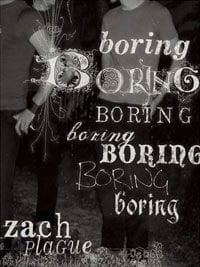
Anyone who has had even a passing experience with the “Art World” or seen a documentary such as Who the #$&% Is Jackson Pollock? would know that it is ripe for satire. In that aforementioned documentary, for instance, maddeningly flimsy arguments are made against a work’s authenticity which prevent it from being taken seriously by the “Art World Establishment” despite forensic evidence to the contrary. It illustrates all too well how arbitrary definitions of art and literature can be. This is not necessarily news, but the material is nearly endless for anyone taking on this subject and its peculiar yet all-too-human vanities.
Though set in the Art World, the novel boring boring boring boring boring boring boring is not the book to do this. Author Zach Plague (aka Zach Dodson) is one of the co-founders of featherproof press that offers these inventivefree mini-books for download from its web site. Indeed, design is of major concern to Plague. In the novel he provides a different typeface for each character’s name. (He uses different fonts and typefaces throughout his book, and even sets text vertical to the page in some cases.) He provides an appendix that contains the backgrounds of various characters and the town in which the novel is set. He provides an index of topics, places, and characters. He even provides an alternate format for reading the novel; you can buy it as a poster set.
Clearly, a lot of time and effort went into the the very clever design and setup of the novel. But, as the saying goes, “content is king”.
For a work of fiction to function, common convention includes creating some engaging characters who are on some sort of journey (inward or outward) and/or an engaging plot. Since Plague has only provided hints of these conventions, boring boring boring boring boring boring boring remains a collection of incidents that never builds any momentum, and with numerous characters who are largely indistinguishable and interchangeable.
The central struggle of the book concerns the possession of the Gray Book, a notebook of sorts that Ollister gave to his now ex-girlfriend Adelaide. Both are 19-year-old art students at Uni-Arts. The Platypus, who is the Town’s Tastemaker and Powerbroker in the Art Scene, wants the Gray Book. Why? We’re never given a direct reason, but we do know that, in the past, Ollister has made fools of the Platypus-led Art Establishment.
The contents of the Gray Book remain a mystery, which is okay, except there are no clues as to its contents or importance. So it’s hard to get too wrapped up in the occasionally humorous doings of the various holders of the book as it changes hands. Ollister and the Platypus scheme to get the book out of Adelaide’s hands, culminating in Ollister gathering a group of “Art Terrorists” who plot to disrupt the Platypus’s annual big party known as the White Ball.
There are moments that are funny and biting as when Ollister rattles off a list of criteria for what should no longer be allowed as art.
“No more pictures of your friends.”
“No more piss on anything.”
“No more oversized art. Big canvases only make bad art bigger.”
Then there is the scene where Vance rants to the audience at the Uni-Arts Lecture Day:
What’s your plan? To make something that is unique aesthetically, something very personal and anti-social, revolutionary, with the goal of having it institutionalized, subject to a waddling mass of tourists on the walls of a mausoleum, excuse me, museum? Or worse, in a gallery, sold like candy at the movie theatre, undersized portions in oversized boxes…”
Following this anarchic energy would have made for an exciting read and might even have led to something insightful regarding the very paradox Vance rants about. Instead, we are left with a handful of tantalizing bits of what could have been a much better book.

![Call for Papers: All Things Reconsidered [MUSIC] May-August 2024](https://www.popmatters.com/wp-content/uploads/2024/04/all-things-reconsidered-call-music-may-2024-720x380.jpg)



